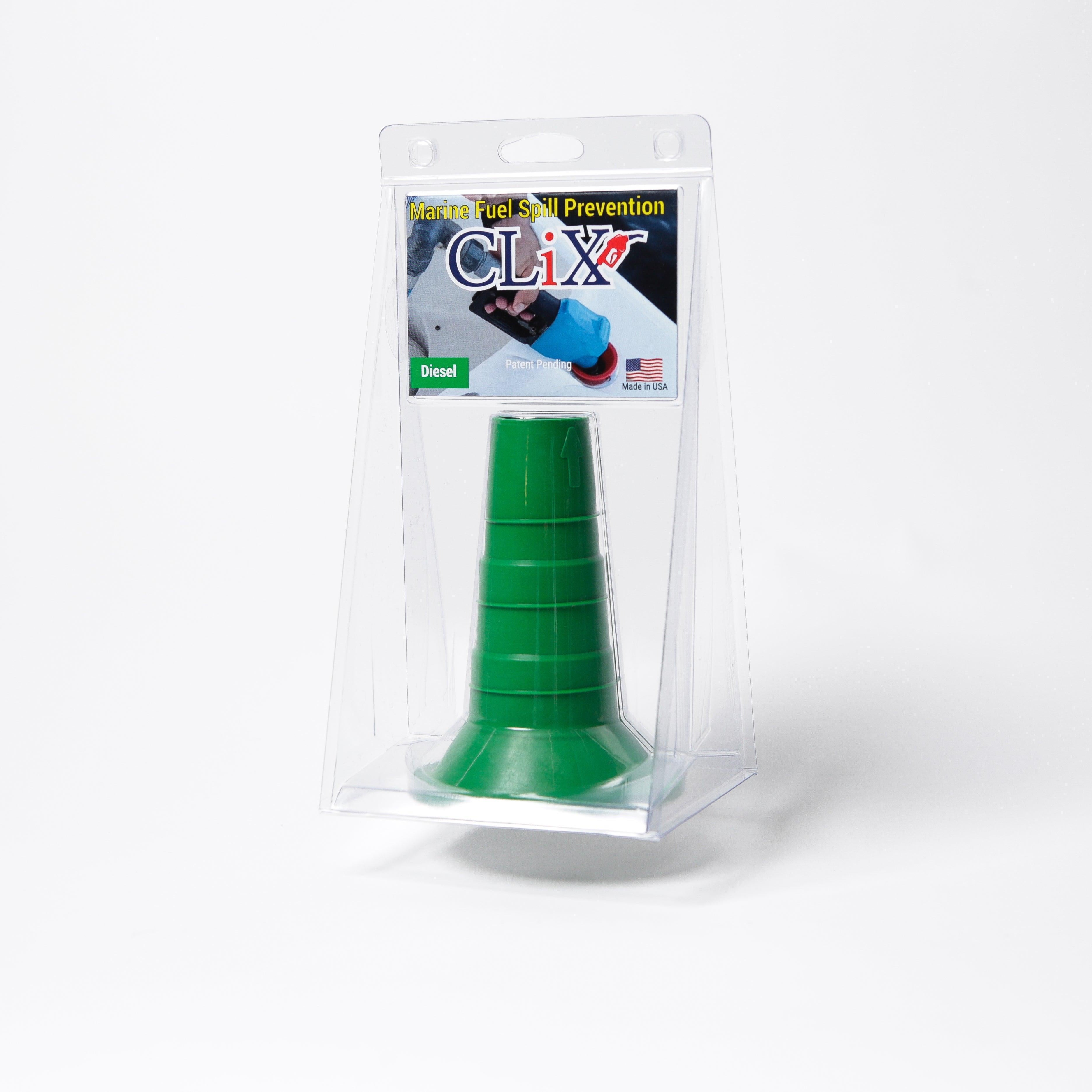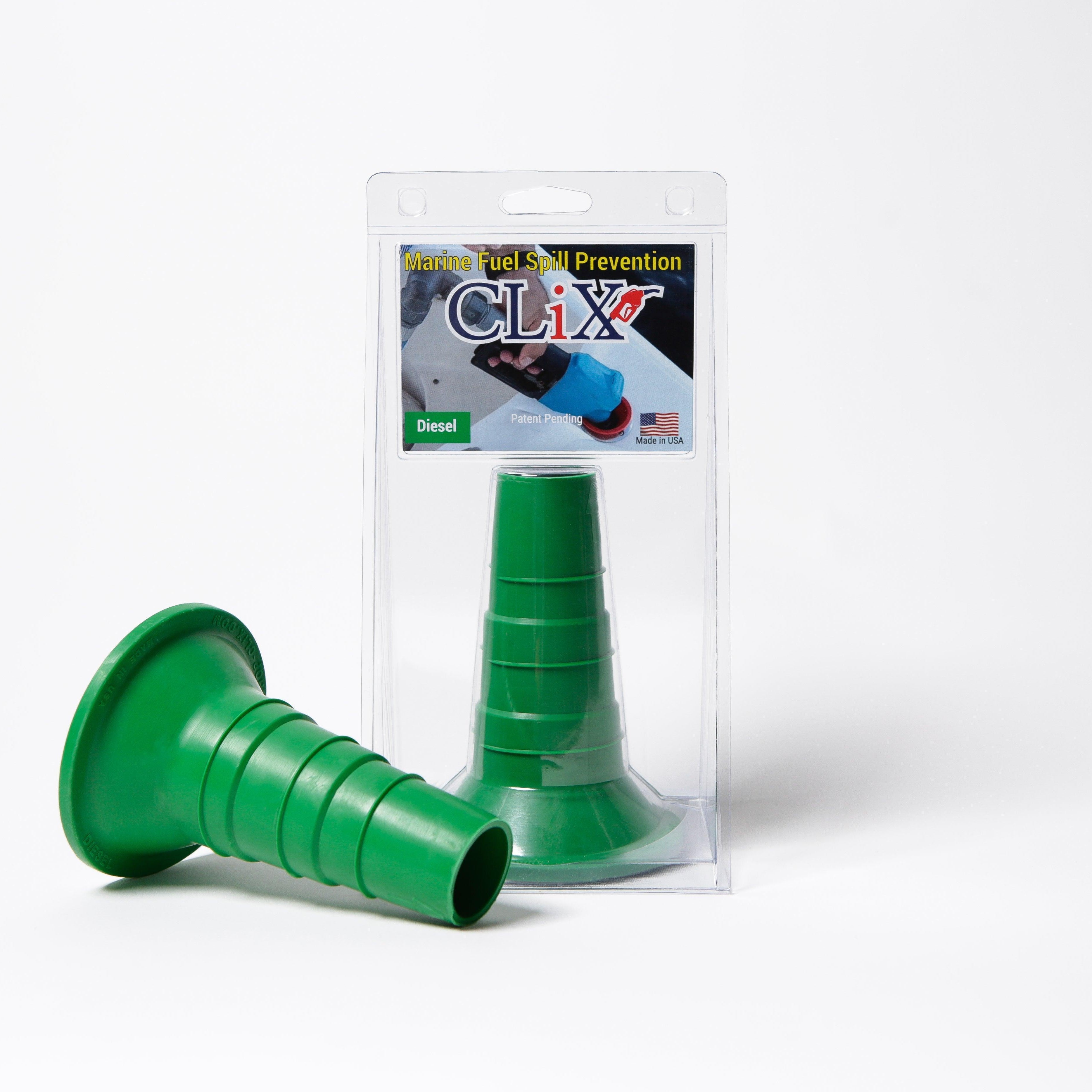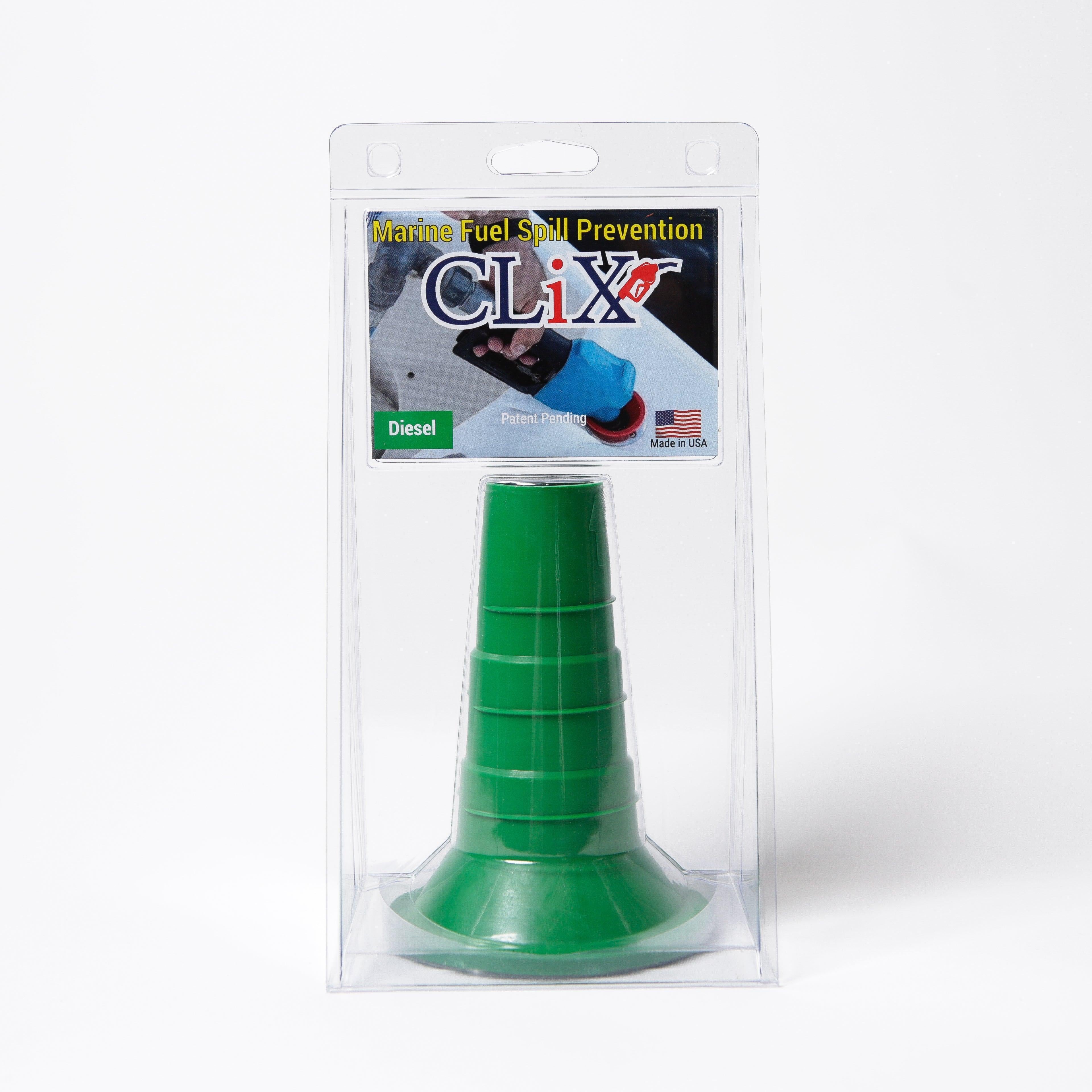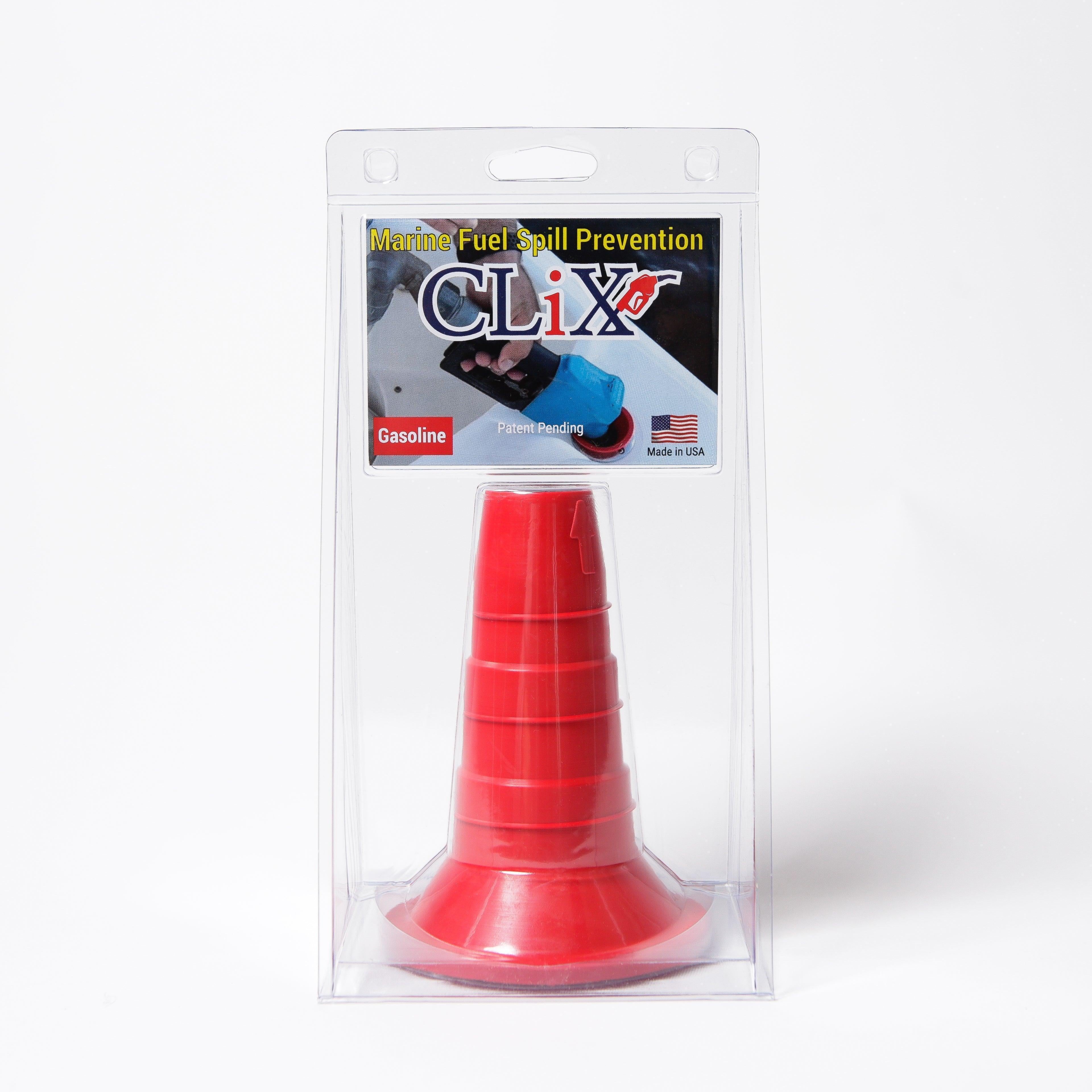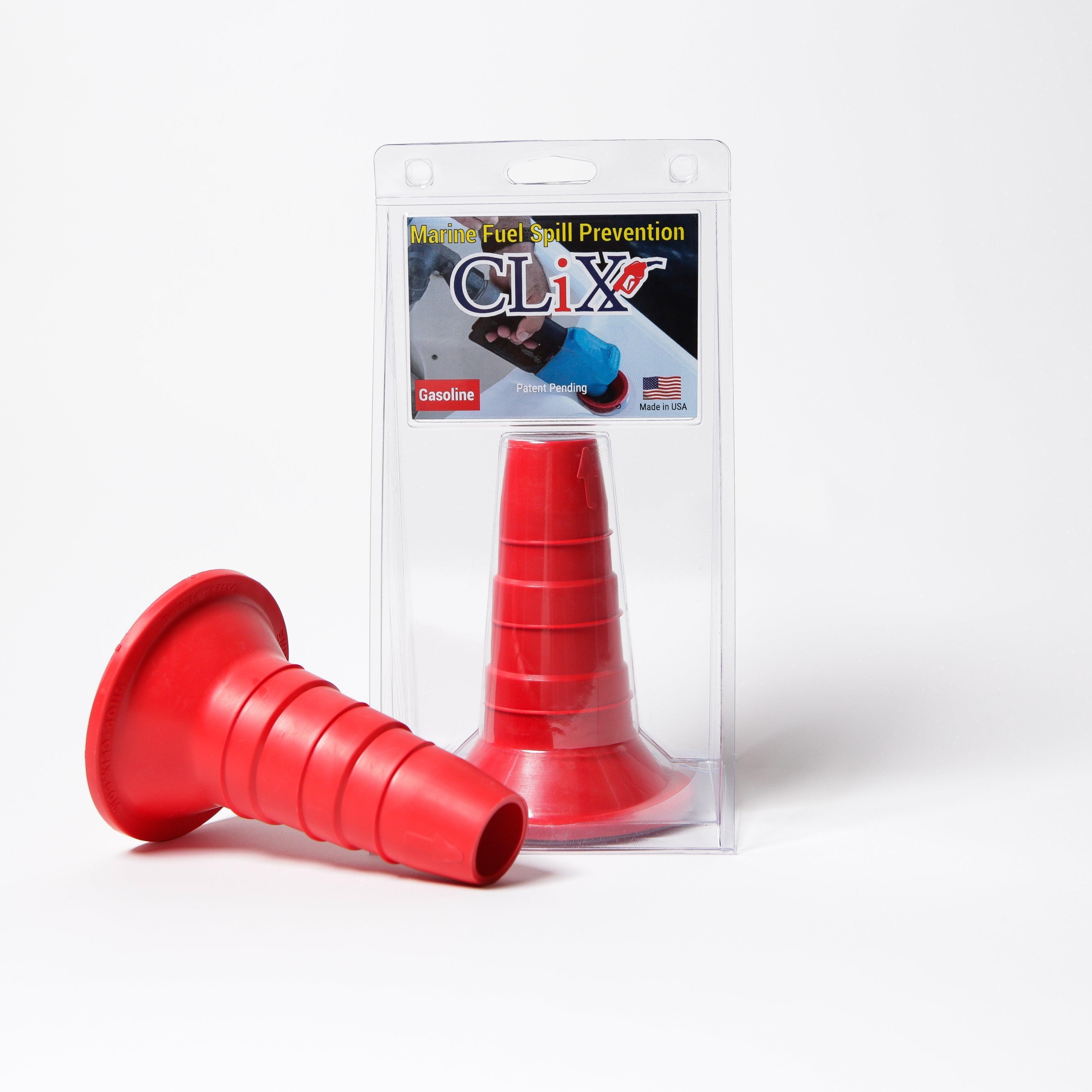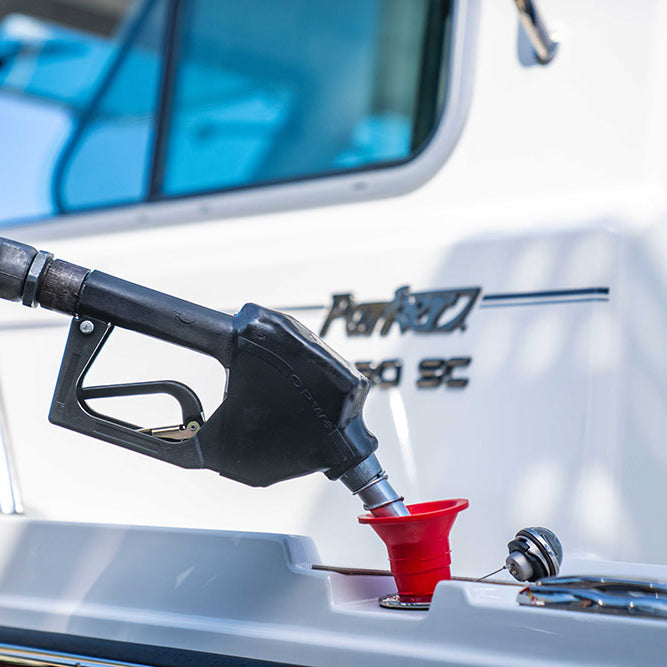So, where’s the best spot to keep your gas cans? Ideally, you want them in a detached shed or a separate outbuilding that gets plenty of air circulation. If that’s not on the cards, a well-ventilated garage is your next best bet, just make sure it’s a good distance from any potential spark sources like a furnace or water heater.
Understanding Ideal Gas Can Storage Locations
Picking the right place to store gasoline isn't just about finding a convenient corner—it’s a major safety call. Gasoline is incredibly volatile stuff. Its vapors are heavier than air, which means they can creep along the floor and find a pilot light or a spark from much farther away than you’d think.
Safe storage really boils down to three things: ventilation, stable temperatures, and distance from anything that can create heat or sparks.
A detached shed is the top recommendation for a reason. It physically separates the fuel from your home, which dramatically cuts down on the risk. If any vapors do leak, they’re outside where they can safely blow away. A garage can work, but you have to be a lot more strategic about it.
Best Practices For Garage Storage
If the garage is your only option, good airflow is non-negotiable. This could be as simple as cracking a window or installing a vent. The idea is to keep flammable fumes from building up.
Crucially, never store gasoline anywhere near appliances with pilot lights (like water heaters or furnaces), electric motors that can spark, or even a hot car engine. Find a spot in the garage that's as far away from these potential ignition sources as possible. For a more detailed breakdown, you can read our full guide on how to store gasoline safely.
Expert Tip: Ventilation is everything. The real danger isn't the liquid fuel itself, but the invisible vapors. Good airflow prevents those vapors from concentrating to dangerous, explosive levels. When it comes to fuel storage, stagnant air is a huge red flag.
To make things simpler, here’s a quick visual guide to help you choose the safest spot on your property.
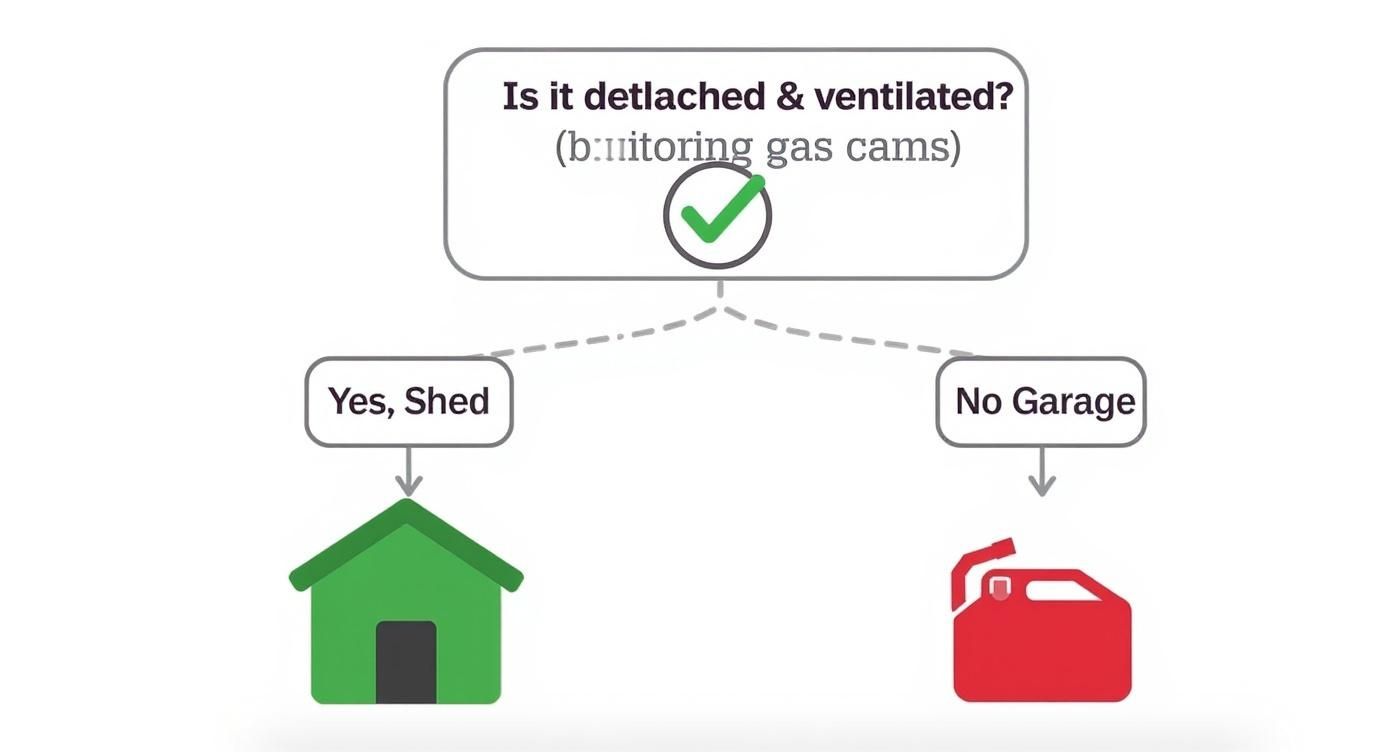
As you can see, a separate, ventilated building always wins. It just hammers home that core principle: keep fuel isolated from where you live.
This table breaks down the good, the bad, and the ugly of gas can storage locations.
Quick Guide Safe vs Unsafe Gas Can Storage Locations
| Location | Safety Rating | Key Considerations |
|---|---|---|
| Detached Shed | Excellent | Ideal. Separated from living spaces, usually well-ventilated. Best option. |
| Well-Ventilated Garage | Good | A solid choice if kept far from ignition sources like furnaces or pilot lights. |
| Car Trunk (Temporary) | Poor | Only for transport. Extreme heat can cause pressure buildup. Not for storage. |
| Basement | Dangerous | Never. Heavy fumes sink and collect, creating a serious explosion hazard. |
| Inside the Home | Dangerous | Absolutely not. Any leak introduces toxic, flammable fumes into your living area. |
Ultimately, a quick check of this guide can help you avoid a seriously dangerous situation.
Absolute No-Go Zones For Storage
Let's be crystal clear: some places are just flat-out dangerous for storing fuel. No exceptions.
Never, ever store gas cans inside your home. This includes attached sunrooms, utility closets, and especially basements. A basement is probably the worst-case scenario because those heavy gasoline fumes can settle in the low-lying space, which typically has poor ventilation, and just sit there waiting for a spark.
Leaving gas in your car's trunk for long periods is another big no-no. The temperature swings inside a vehicle can be extreme, leading to pressure buildup in the can. It’s meant for transport, not storage.
What Modern Gas Can Regulations Mean for You
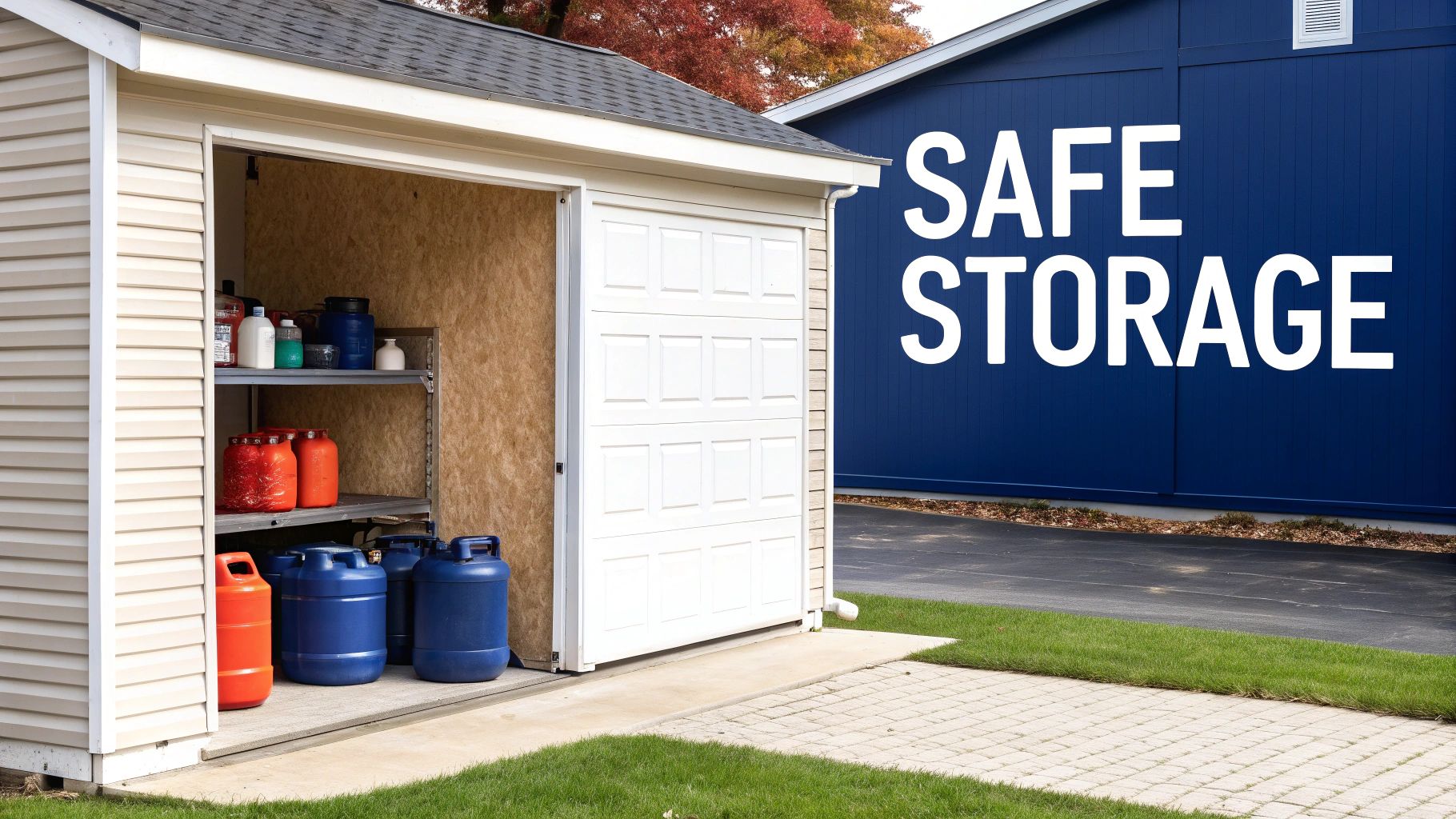
Let's be honest, we've all seen them: that old, faded red gas can tucked away in a garage corner, probably decades old. While it might seem fine, it's a relic from a different era of safety. The technology behind fuel containers has come a long way, and sticking with an old can means you're missing out on features that could prevent a real catastrophe.
The game changed significantly on July 12, 2023, when the Consumer Product Safety Commission (CPSC) introduced a mandatory safety standard for any new portable fuel container sold in the U.S. The biggest requirement? Every new can must now have a flame mitigation device (FMD). This simple-sounding part is designed to stop a terrifying event called a flashback explosion, where flames from an outside source can shoot back into the can and ignite the gas vapors inside.
Key Features of a Modern Compliant Gas Can
So what exactly makes a new gas can better? It's not just one thing. The entire design has been rethought to address the common weak points of older models. Your can is your first line of defense, so knowing what to look for is crucial.
Here’s what every safe, modern gas can should have:
- Flame Mitigation Device (FMD): This is the most critical update. It's usually a small mesh screen or a special insert in the spout opening that acts as a flame arrester, stopping a fire from getting inside the can.
- Self-Closing Spout: Remember the old screw-on caps that were easy to lose or leave off? Modern cans have spring-loaded spouts that automatically seal shut the moment you stop pouring. This is huge for preventing spills and reducing the escape of flammable fumes.
- Durable Construction: New cans are built from tough, high-density polyethylene (HDPE). This material is designed to stand up to gasoline and harsh UV rays without becoming brittle or developing leaks over time.
A flashback explosion happens faster than you can blink. Picture this: you're pouring gas near a hot engine or a water heater pilot light. A single spark ignites the vapor trail. Without an FMD, that flame races up the stream of fuel and into the can, causing a violent eruption. Modern cans are engineered specifically to prevent this exact scenario.
Understanding Residential Storage Limits
Now, even with the best can, you need to know the rules for how much fuel you can safely keep at home. While you should always check your local fire codes, the National Fire Protection Association (NFPA) provides a solid, widely adopted guideline.
For a typical home, you're generally allowed to store up to 25 gallons of flammable liquids like gasoline. But here's the important part: that fuel must be in approved containers, and no single container can be larger than 5 gallons.
So, you can have five 5-gallon cans, but you can't have one 25-gallon drum. This is a practical rule designed to limit the amount of fuel that could feed a fire, making an emergency much more controllable for first responders. Adhering to this limit is a non-negotiable part of safe fuel storage.
Setting Up a Safe Fuel Storage Area at Home
Knowing where to store your gas cans is just the starting point. To do it right, you need to create a dedicated storage area—a zone specifically designed to minimize risk. It's not about just shoving cans in a corner; it's about thinking through elevation, separation from heat, and proper containment.
The main goal here is simple: keep your fuel and its fumes far away from anything that could possibly ignite them. This isn’t just a friendly tip; it's the bedrock of fire safety. Those gasoline vapors are invisible, heavier than air, and can travel a lot farther than you might think.
Isolate from Ignition Sources
Your most important job is to create a buffer zone between your fuel and any potential spark. Most garages have a furnace, water heater, or other appliances that have pilot lights or electric motors, all of which are potential ignition sources.
As a solid rule of thumb, you want to keep at least 50 feet between your fuel cans and any appliance that gets hot or could create a spark. This includes some common culprits:
- Furnaces and boilers
- Water heaters
- Clothes dryers
- Freezers or refrigerators (their compressors can spark)
- Any area where you use power tools or welding equipment
Now, I know a 50-foot gap isn't realistic for every garage. If you can't manage it, do your best to maximize the distance and, if possible, put a physical barrier like a solid wall between the fuel and the appliance.
Key Takeaway: Start thinking of your storage spot as a strict "no-spark zone." If something can get hot, produce a flame, or throw a spark, it doesn't belong anywhere near your gasoline. Adopting this mindset is the single most important step you can take.
Proper Placement and Containment
Once you've picked a spot far from heat sources, let's talk about where the cans actually sit. You should never store gas cans directly on a concrete floor. Concrete tends to draw and hold moisture, which can cause metal cans to rust out from the bottom—a sneaky leak waiting to happen.
Even with plastic cans, the temperature difference from the cool concrete can cause the plastic to expand and contract over and over, eventually weakening the seams. The fix is easy and cheap: just lay down a piece of scrap plywood or a small plastic pallet to create a barrier. This simple step keeps the can elevated, dry, and at a more stable temperature.
While you’re at it, think about secondary containment. Placing a spill tray or a shallow plastic bin under your cans is a great, low-cost way to catch any surprise drips or small leaks. It keeps a minor issue from becoming a dangerous mess that spreads across your floor. Of course, the container itself matters, too. For some great options, check out our guide to the top portable gasoline container picks for safe fuel storage.
Secure and Ventilate the Area
Finally, make sure your storage zone is both secure and well-ventilated. This space needs to be completely inaccessible to children and pets. If you aren't using a locked shed, a dedicated, lockable flammable storage cabinet is the gold standard for safety.
Good airflow is also crucial for preventing any fume buildup. If your garage or shed gets stuffy, crack a window open or consider installing a small vent near the storage spot to keep fresh air moving. Remember, this is just one part of your home's safety plan. It's always a good idea to brush up on general home fire safety guidelines to keep your entire property protected.
Storing Fuel Safely in a Commercial Workplace
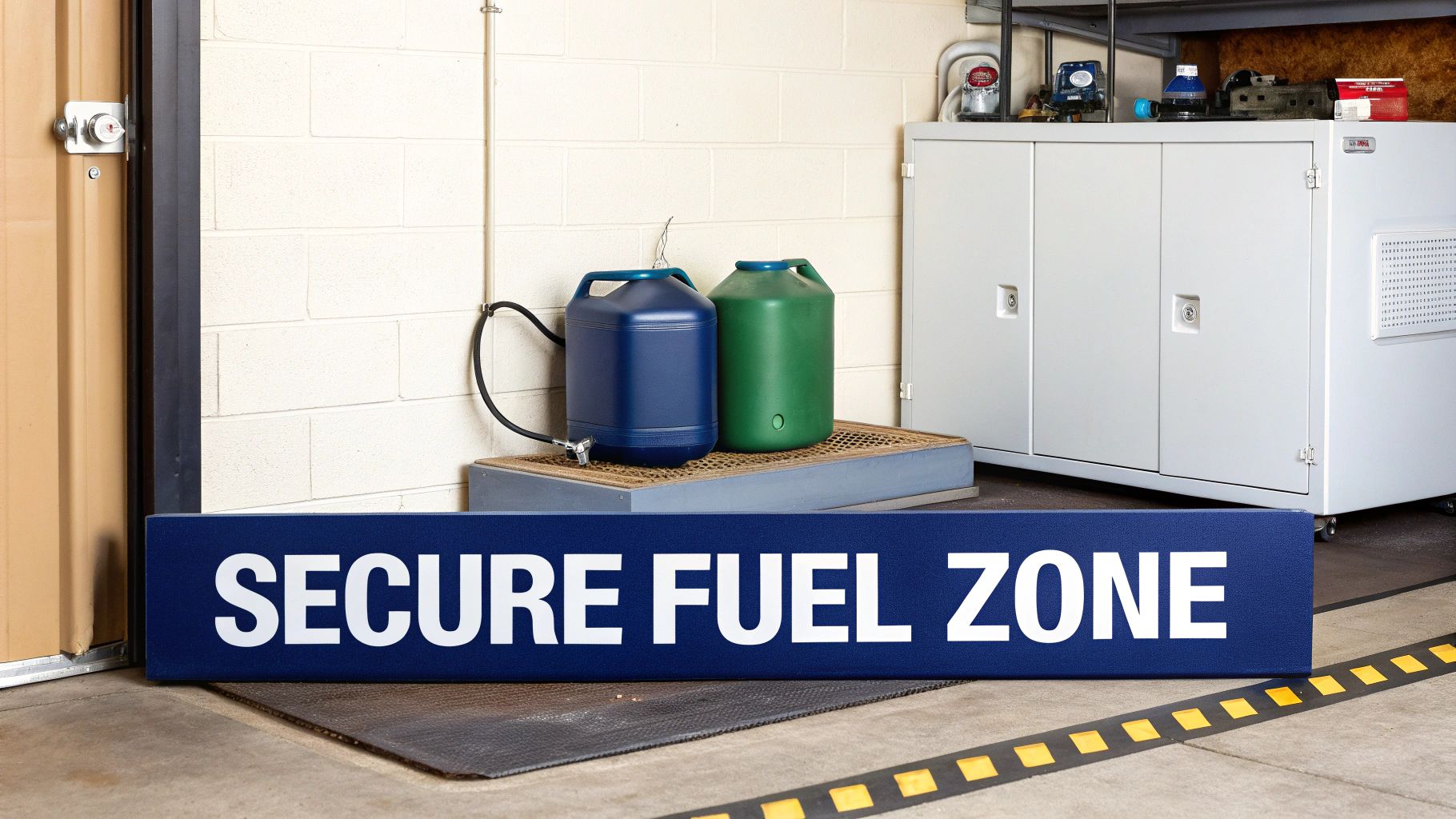
When you're dealing with gasoline in a business setting, the casual storage rules of a home garage go right out the window. For contractors, landscapers, or any commercial operation, compliance with Occupational Safety and Health Administration (OSHA) standards isn't just a good idea—it's the law.
The stakes are much higher, and the regulations are far stricter. So, let's break down what you actually need to do.
What Makes a "Safety Can" a Safety Can?
First things first, you can't just run to the hardware store and grab a standard red plastic can. In a commercial environment, you're required to use what's officially known as a "safety can." They might look similar, but a true safety can is a specialized piece of gear built to meet tough workplace standards.
These cans are engineered for durability and accident prevention. You'll find a few key features that set them apart:
- Spring-Closing Lid: This isn't just for convenience. The lid is designed to be self-closing and leak-tight, which is huge for preventing vapor escape and spills if the can gets knocked over.
- Flame Arrestor: This is a critical safety feature. It's a metal mesh screen inside the spout that stops outside flames from igniting the vapors inside the can, preventing a dangerous flashback explosion.
- Positive Pressure Relief: If the can is exposed to high temperatures (like being left in a hot truck or near a fire), this safety valve automatically vents excess pressure. This prevents the can from rupturing.
These features work together to create a container that can actually withstand the rigors of a busy worksite. For larger operations, you might even need to look into dedicated metal building warehouse solutions to create a secure, compliant storage area.
Key Takeaway: OSHA standard 1910.106(a)(29) is the rulebook here. It sets clear, non-negotiable requirements for these containers. It mandates that safety cans must hold no more than 5 gallons and be certified by a testing lab like UL.
Consumer Gas Cans vs Commercial Safety Cans
It's easy to get these two confused, but their approved uses and built-in safety features are worlds apart. Using the wrong can on a job site isn't just a minor mistake—it's a serious violation that can lead to fines and, more importantly, put people at risk.
Here’s a quick comparison to highlight the critical differences.
| Feature | Standard Consumer Gas Can | OSHA-Approved Safety Can |
|---|---|---|
| Lid Design | Manual screw-on cap; not always self-sealing | Spring-loaded, self-closing, leak-tight lid |
| Flame Arrestor | Not typically required or included | Mandatory metal screen to prevent flashback explosions |
| Pressure Relief | May have a simple vent, but not designed for fire exposure | Positive pressure relief valve that vents automatically |
| Construction | Usually high-density polyethylene (plastic) | Heavy-gauge steel or durable plastic; built for abuse |
| Capacity Limit | Varies, but often available in multiple sizes | Maximum of 5 gallons per OSHA regulations |
| Certification | Meets EPA/CARB standards for emissions | UL or FM certified to meet specific safety standards |
| Approved Use | Residential use only (lawnmowers, personal vehicles) | Commercial and industrial workplaces |
Understanding this table is the first step toward building a compliant and safe fueling protocol for your business. The right equipment is non-negotiable.
Storage Cabinets and Quantity Limits
You can't just line up dozens of safety cans in a corner, even if they're the right type. OSHA also has strict rules about how much gasoline you can store openly versus what needs to be locked away.
In any commercial workplace, you can have no more than 25 gallons of flammable liquids stored outside of an approved storage cabinet.
If your needs exceed that amount, you absolutely must use a dedicated flammable liquid storage cabinet. These aren't just any old metal lockers; they are specially constructed, double-walled steel cabinets designed to protect their contents from a fire for a specific period.
Inside one of these approved cabinets, you can store up to 60 gallons of gasoline.
Managing these quantities also means having your paperwork in order. This is where a clear spill prevention plan template becomes an essential part of your safety protocol. It’s not just about finding a spot for your gas cans; it's about creating a complete safety system that protects your people and keeps you compliant.
Storing Gas Cans on Your Boat and at the Dock
Storing fuel on a boat is a different ball game entirely. You're not just finding a corner in a garage; you're dealing with constant motion, direct sunlight, and often a corrosive saltwater environment. The safety stakes are incredibly high.
The biggest difference is that a boat is always moving, which means cans can tip, slide, and spill if they aren't completely secured. More importantly, gasoline vapors are heavier than air. On a boat, they can sink down into the bilge—the lowest part of the hull—creating an invisible, highly explosive hazard.
Playing by Marine Safety Rules
Once you're on the water, you fall under U.S. Coast Guard (USCG) regulations, and they have clear rules about portable fuel containers. Ventilation is everything. You absolutely cannot store a gas can in an enclosed, unventilated space like a cabin or a sealed locker. Fumes can build up in a heartbeat, and with no way to escape, they create a ticking time bomb.
The gold standard is to store cans on deck where the open air can safely whisk away any potential vapors. Of course, they can't just be sitting there. They need to be locked down tight so they don't tip or slide around, even when the water gets rough. A dedicated rack or heavy-duty straps are your best friends here.
Boater's Tip: Always keep your portable gas cans standing upright. Laying them on their side puts constant pressure on the cap and spout seals, which can easily lead to leaks and dangerous fumes.
Best Practices for Storing Cans On Deck
Properly securing your fuel cans is about more than just preventing a spill. A loose 5-gallon can becomes a dangerous projectile in choppy seas, capable of damaging your boat or, worse, injuring someone.
Here’s how to do it right:
- Use a Dedicated Rack: Investing in a purpose-built fuel can rack is the safest bet. It’s designed specifically to hold the container snugly and securely.
- Strap It Down: If you don't have a rack, use heavy-duty, UV-resistant straps. Lash the cans to a solid, fixed point on the boat, like a railing stanchion.
- Mind the Heat: Keep the cans as far away as possible from engine exhaust ports or any other heat source on deck.
Don't forget about the rules when you're tied up, either. Many marinas have their own strict policies, often banning portable gas cans from being stored on boats while docked. It’s always smart to check in with your marina operator to make sure you're following their rules, keeping you compliant both on and off the water.
Answering Your Gas Can Storage Questions
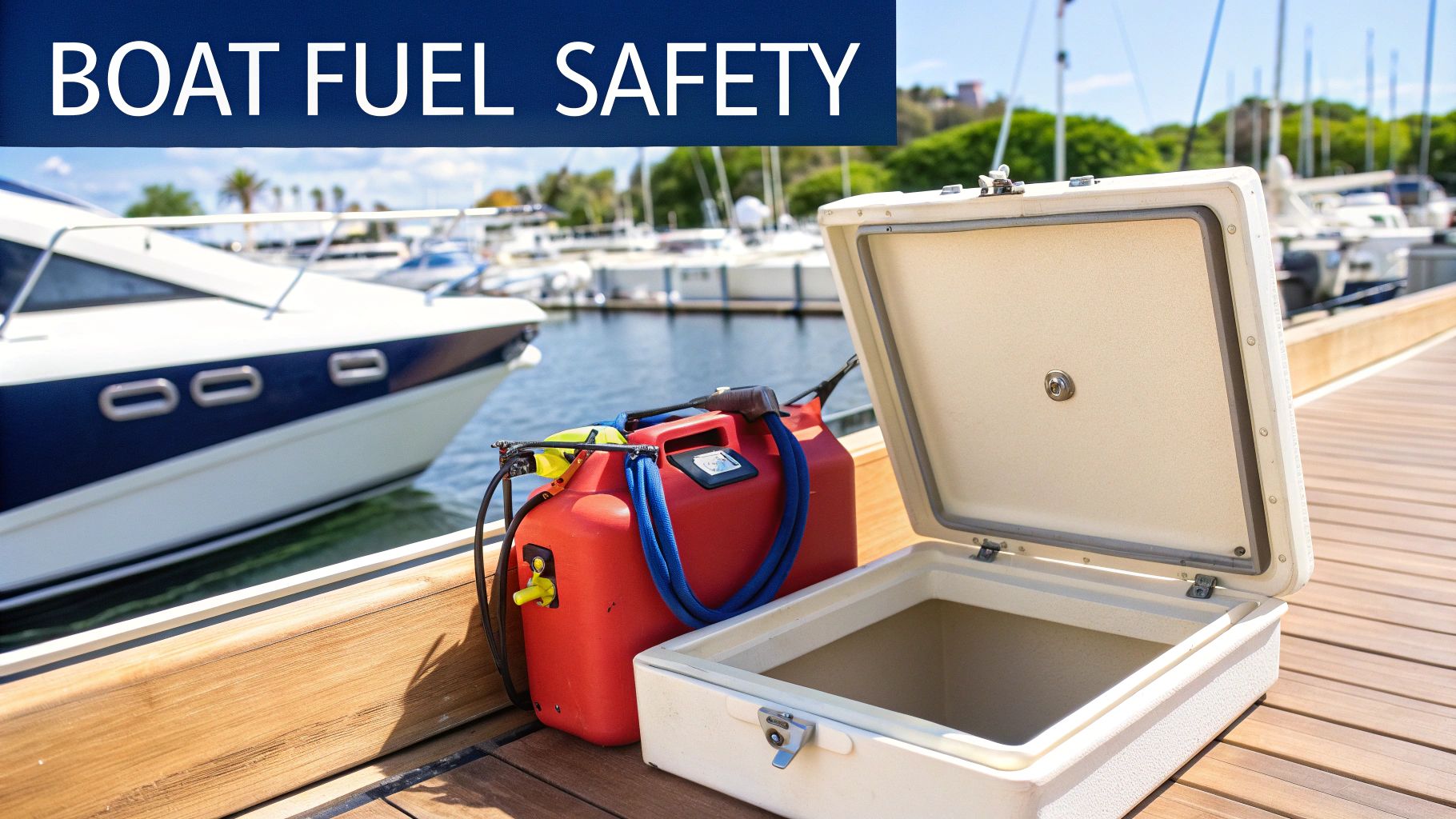
Even when you know the basics, a few specific questions always seem to pop up. Let's tackle some of the most common dilemmas people face when storing gas. These are the real-world details that make all the difference in keeping your fuel (and yourself) safe.
How Long Can I Store Gasoline in a Can?
Plain old gasoline starts breaking down faster than you'd think—sometimes in as little as 30 days. The ethanol in it attracts moisture, and that's the beginning of the end.
But with a good fuel stabilizer, you can push that timeline way out, keeping gas fresh for up to two years. Just make sure to add the stabilizer right after you fill the can. I always use a permanent marker to write the date I filled it and when I added the stabilizer right on the can. It’s a simple habit that ensures you’re always using the oldest fuel first.
Can I Store a Gas Can on a Concrete Floor?
You see it all the time, but storing gas cans directly on a concrete garage floor is a bad idea. This goes for both metal and plastic cans.
Concrete has a tendency to "sweat" or draw moisture up from the ground, which will rust out the bottom of a metal can over time. With plastic cans, the constant temperature difference between the cool floor and the ambient air causes the plastic to expand and contract. This process can stress and weaken the seams, eventually leading to a leak.
The fix is easy: just slide a piece of scrap plywood or a small pallet underneath to create a barrier.
Is It Safe to Store a Gas Can in My Car Trunk?
The trunk of your car is perfectly fine for getting the gas can home from the station. For anything longer than that? Absolutely not.
A car's interior can heat up like an oven, especially in direct sunlight. That heat causes the fuel to vaporize, building up a dangerous amount of pressure inside the can. This can lead to leaks or, worse, fill your trunk with highly flammable fumes.
The minute you get home, take the can out of your vehicle and move it to its proper storage spot. Don't put it off.
A swelling or bulging gas can is the most obvious red flag you'll see. It’s a direct sign of too much pressure from heat. When you see this, you need to move the can to a cooler, shaded location right away to prevent it from rupturing or leaking.
What Should I Do if My Gas Can Starts to Swell?
A bulging gas can is a serious warning sign. It means vapor pressure inside has reached a dangerous level, usually because it got too hot. You need to handle it carefully.
- Move it to a cool, shady spot. Get it out of the sun and away from anything that could ignite the fumes. Be gentle.
- Let it cool down completely. Don't even think about opening it while it's still swollen. The pressure needs to come down naturally as the can cools.
- Vent it very slowly. Once it’s cool to the touch, slowly and carefully twist the cap to release the built-up pressure. You should hear a hiss.
If you find a can is swelling often, it's a sign that something is wrong. Either its vent is failing, or you're consistently storing it in a place that's too warm. This is a big deal—mishandling pressurized containers led to 6,280 nonfatal injuries in a single year, which shows why you have to take this seriously. You can find more on the risks and official safety protocols for pressurized containers.
If it keeps happening, just replace the can. It’s not worth the risk.
At CLiX Fueling Solutions, we believe safety shouldn't stop at the shore. Our spill-free fueling system takes the worry out of filling up, protecting your boat and the water from messy overfills. See how you can get a smarter, safer fuel-up at https://clixfueling.com.

